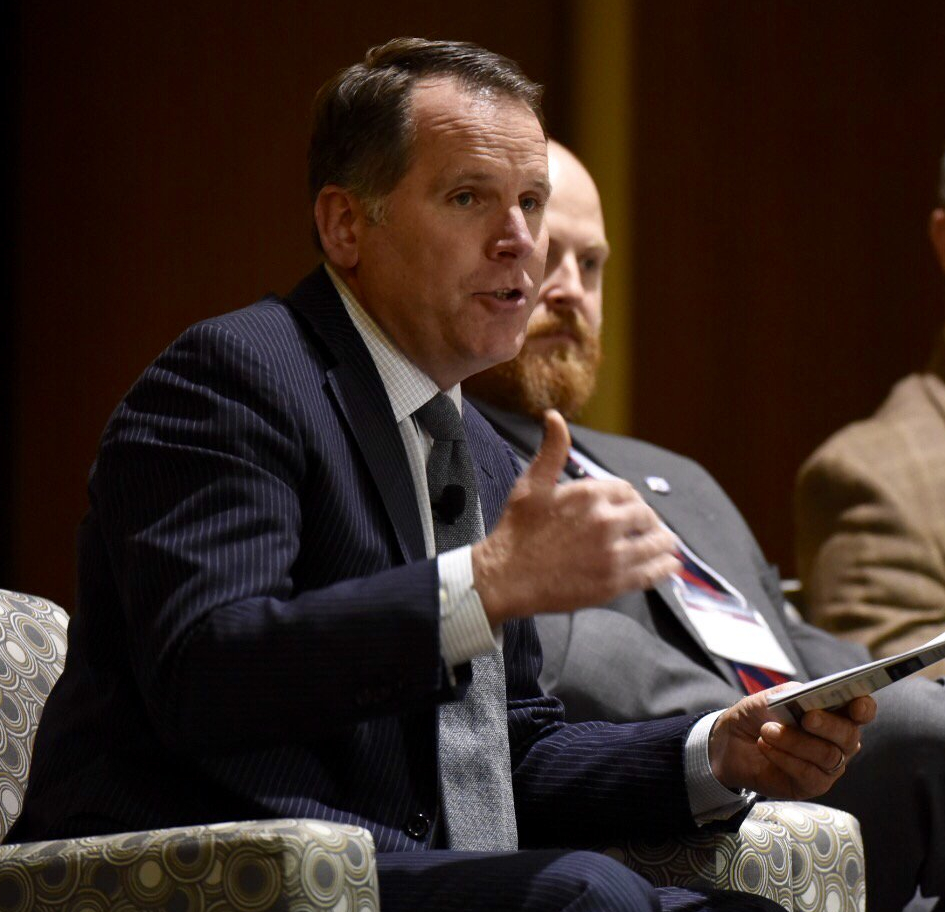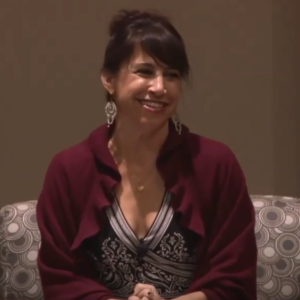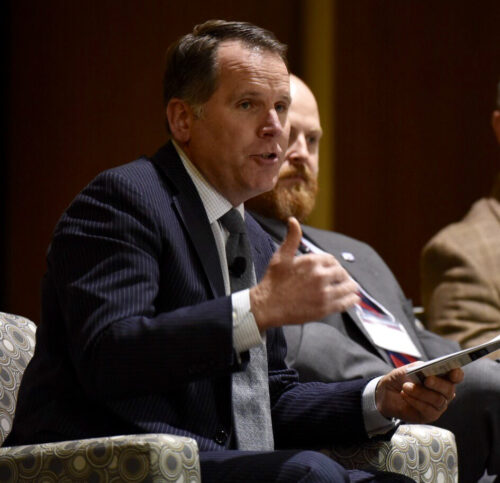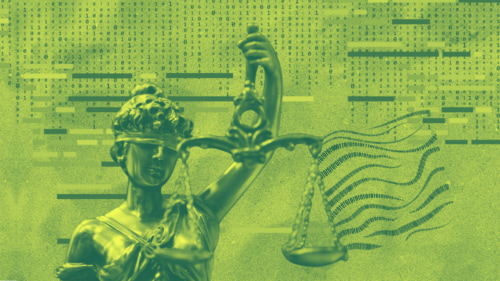
Michael Hayes moderates a panel at the Texas Fatherhood Summit in 2016.
We know that economic concerns weigh heavily on survivors and most certainly impact their decision-making, even their safety decision-making around whether or not to exit a violent relationship.

Krista Del Gallo
For survivors of domestic violence, financial insecurity is often a huge problem. Without enough money to support themselves and their families, survivors have a hard time gaining independence from abusive partners. Child support is often a crucial resource, but filing for it, collecting payments, and enforcing orders all present potential safety risks. In this New Thinking podcast, Michael Hayes from the Office of Child Support Enforcement and Krista Del Gallo from the Texas Council on Family Violence talk with Robert V. Wolf about strategies that states and the federal government are promoting to help survivors safely access child support.
This podcast was supported by Grant No. 2015-TA-AX-K023 awarded by the Office on Violence Against Women, U.S. Department of Justice. The opinions, findings, or recommendations expressed in this podcast are those of the speakers and do not necessarily reflect the view of the Department of Justice, Office on Violence Against Women.
The following is a transcript of the episode.
KRISTA DEL GALLO: We know that economic concerns weigh heavily on survivors and most certainly impact their decision-making, even their safety decision-making around whether or not to exit a violent relationship.
ROBERT V WOLF: This is Rob Wolf filling in for the voice you’ve grown accustomed to hearing these last few months, the irreplaceable Matt Watkins who’s away on holiday. That means I’m your host for this New Thinking episode, which today is looking at the intersection of complicated topics, child support and domestic violence. The sad truth is that in families affected by domestic violence, the ability of the parent who is caring for children to get child support payments from the other parent can be fraught with challenges and even danger. And yet, child support payments are really important. First, for kids, to make sure their needs are met. But also for the parent, who is trying to gain financial independence and break free of an abusive relationship.
Fortunately, there are people thinking hard about these issues and two of them are with me today. Michael Hayes is on the line from Washington D.C. He works in the federal office of Child Support Enforcement, Division of Program Innovation where he’s responsible for the offices Parenting Time Portfolio, leads work on domestic violence policy, and oversees multiple grant projects.
With me on the line from the El Paso County Courthouse, where she is working on a particular project today is Krista Del Gallo. Policy Manager for the Texas Council on Family Violence. A statewide organization that’s based in Austin, actually. The Texas Council is one of the largest Domestic Violence Coalitions in the country. Since 1978, has been a leader in the efforts to end family violence. Krista focuses in her work on researching, analyzing, and promoting laws, policies, and options that expand the critical social safety nets for survivors of family violence.
I want to thank you both for joining me today.
MICHAEL HAYES: Great to be here, thanks.
KRISTA DEL GALLO: Thank you.
WOLF: So, I’d like to start with Krista. Victims of domestic violence are connected to their abusers in countless ways. Emotionally, through the kids they might be raising together. But they’re also tied financially. That means, if a victim wants to leave an abuser, they have to think about how they’ll make ends meet. Can you explain how the fear of losing financial stability can factor into someone’s decisions to stay with or maybe even return to an abuser?
DEL GALLO: Oh, absolutely. We know that economic concerns weigh heavily on survivors and most certainly impact their decision making. Even, their safety decision making around whether or not to exit a violent relationship. There is a bidirectional relationship between domestic violence, and poverty, and this idea of financial instability. People that are living in poverty are actually at increased vulnerability for domestic violence and other types of community-based violence because they have limited options for safety. And there are definitely significant costs associated with leaving, or attempts to gain some type of freedom, or relief from violence, or that violent partner.
To truly feel safe, like everyone else that’s particularly parents in this world, we include financial solvency in that description or that definition. And so what real safety is, what we’re thinking about it and how survivors have articulated it for us, is really broader and really thinks more about family stability. That’s where child support fits in, because child support is one of the most effective ways for a family that is co-parenting to actually have that economic solvency if they are regularly receiving financial and medical support from the other parent.
WOLF: I understand that a lot of women have trouble accessing this support, child support. I saw a number from the National Conference of State Legislatures that said that more than 90 percent of women who have left a relationship and who have experienced domestic violence would pursue child support if they could do so safely.
Michael, can you give some background? First on child support in general, just to give a sense of how one goes about obtaining it, and then, can you discuss some of the unique safety and other challenges that survivors of domestic violence face that sometimes makes it very difficult for them to access this very important resource that they need to, as Krista says, maintain their family and family stability?
HAYES: Sure. To give a little background, there are kind of a couple different ways that people get into the child support program and maybe even, it would be helpful to back up and just note that for some people, when they think about child support, they think about a couple that has been married, they split up, they hire attorneys to file divorce paperwork, and those are kind of private family law cases.
The system for which I work, and they talk mostly about, is the public system of child support. So there’s Federal funding provided through the Social Security Act to all states, and territories, and Indian Tribes that have been certified, to provide a public system of child support services. It’s primarily going to be parents who were not married to each other, or very low income, couldn’t afford to go through the court process and they access the child support system in a couple different ways.
One is, a parent may be receiving some kind of public assistance, and as a condition of receiving that safety net support, they are referred to the child support program. Another way is that parents may not be receiving any safety nets, public assistance, cash assistance, or something like that. But because they couldn’t afford an attorney or didn’t have resources to hire an attorney to enforce child support orders, they come to the public system and apply for services. So there’s kind of two routes into the child support program.
In 2016, which was the last year for which we have audited data, the child support program nationally served about 15.6 million children. So that’s one in five children in the U.S., making it one of the largest anti-poverty programs in the country. By comparison, only two million children received cash assistance through the public welfare programs, so, striking larger program for child support. And just in terms of amount of money that flows through the program in 2016, it was $33 billion. Almost all of that goes to the families. A very small percentage, a little less than five percent is used as cost recovery for the government / welfare program.
WOLF: The 33 billion, then, is money that’s coming from the non-custodial parent to the parent who is in fact taking care of the child? That’s not actually federal money?
HAYES: Yes. The 33 billion dollars is money that’s collected from … The terms that’s often used is non-custodial or the parent who owes support and that 33 billion is transferred to the parent who is taking care of the child primarily. Or the child may reside primarily in their household.
That’s an overview of the child support program. The specific kind of challenges that come into play for a survivor of domestic violence starts kind of from the very beginning, even in applying for services because that applying for child support services could be kind of the first official signal to the other parent, so the non-custodial parent, that they’re not coming back into the relationship. That they’re actually leaving for good.
And that is risky because it challenges the batterer’s tower in that relationship. And it gets even trickier for a parent who’s gone and applied for cash assistance, for public assistance, because they may not understand there’s going to be this automatic referral of their information over to the child support program to establish a child support case, and the first they may recognize this is when the child support agency contacts them or contacts the other parent to get information to start processing the case. That can be this total surprise and not a good surprise for either of them and trigger violence. But then the whole thing is fraught, as you said in your introduction with danger because you’re talking about money, and family, and the children, and who’s got some power in the relationship.
So if you’ve got a survivor who has left and is really working to not let their batterer know their whereabouts, their address. Court documents may have both parents addresses on them. Or there may be a requirement in court to give address information or work out where you’re going to exchange the children. It gets even more and more complicated, but I think that’s a good tip of the iceberg, at least.
WOLF: So, Michael, you said 15 million children are receiving child support through the public mechanism. I’m wondering if cases where there is domestic violence are in any way flagged so that the people who are assisting these families and trying to put the child support payments in place are aware that there might be some danger here. Or risk to the survivors and their children.
HAYES: There are a couple ways that cases are identifying in the child support program where family violence, or domestic violence, is a concern. There’s one standard flagging mechanism that is generally called the family violence indicator. Every state has to adopt their own policies for determining when appropriate to put the family violence indicator on a on a case. The baseline is that if the state, or if it’s a tribal child support program, has reason to believe that disclosure of the victim/parent or the children’s address would pose a threat of physical or emotional harm to that victim/parent and/or children, then the state is required to put the family violence indicator on the case. That essentially creates address suppression or an address non-disclosure for the federal system. It doesn’t necessarily then transfer to the state court system and that’s where the second piece comes into play, in that most states then have a policy and procedures in place to ask their courts for non-disclosure. Sometimes they happen at the same time, both the federal and the state flagging, but it’s a complicated process. So it’s hard to explain it, even here on the podcast, in simple terms. Imagine how much more complicated it is if you’re a victim parent who’s trying to access this, since states have varying degrees of explanation of the process.
And so we have nationally about nine percent of our child court cases of the custodial parents, the parents with custody, have a family violence indicator flagged on their case. It’s been going up slowly over the last three or four years, but there are still some states where less than one percent of cases are flagged with the family violence indicator. And there are some bureaucratic and legal hurdles to getting that indicator on your case. This also means that some parents maybe aren’t coming into the child support system because of their fear of what it could bring for them.
WOLF: Let’s look at Texas as an example to get a sense of what kind of work can be done to address the safety concerns of survivors and help them access the child support payments to which they are entitled.
So Krista, the Texas Council on Family Violence, where you work, has done a lot of ground breaking work in this area, and I understand you work with the Office of the Attorney General in Texas to try to support efforts to improve access to child support. Could you talk about some of the steps you’ve taken and about your collaboration with the office of the Attorney General, and in particular their Texas Child Support Division?
DEL GALLO: Certainly. I know when I started doing more broader work in terms of economic policy on behalf of domestic violence survivors, I started to see the huge importance of paying attention to the child support system,
So we started to meet with our child support division just to gain a better understanding of that system. And unfortunately in the mid-2000’s we had a couple of very tragic fatalities that were connected to the establishment or enforcement of a child support case, which very rightly propelled both the Texas Council on Family Violence and our Child Support Division to intensify our relationship and our work together. And that really started off with the creation of a Domestic Violence Child Support Work Group within the child support division.
And one of the first things that we started to work on, and I think it’s helpful that Michael noted this, it’s really pushing out awareness information, because this is such a complicated system, particularly for parents that are overwhelmed by just the separation and by the court process or the system, but also in this case, by the fact that domestic violence has occurred.
One of the first creations in our work together were posters that just talked about the child support process and the components of it, and what survivors’ options were in that process for safety. We also started working on a public facing website called Get Child Support Safely, which has been updated several times. We’re actually going be updating it again soon. That’s in English and Spanish and really just works on getting information about the process and the protections available out to the public.
We created some other collateral brochures, letters that went out with every notice of a court hearing to people within the child support system. And so more of this idea of universal information, so that we were encouraging people to have the understanding of why they would want to disclose or share information around their concerns with the child support division. Because that’s not intuitive. When a parent goes to apply for child support services, it’s because they need money, right? They’re not going there for domestic violence counseling or for a support group; they’re going for actual financial support. And so it doesn’t make a lot of sense for them to share all of this other information with this government agency unless they’ve been informed that there are options available, that there are parts of this process that they might not have been aware of and that might cause some safety concerns for them, and that we really promote discussion between survivor parents and the Child Support Division about those concerns so that they can be safely addressed and attended to.
And following some of that more public-facing collateral, we started to look inward, and really the Attorney General’s Office, the Child Support Division in Texas did some of the real ground breaking work by overhauling all of their policy around family violence and how they addressed it at every level of staffing. And that also included mandatory training on family violence for all staff in the Child Support Division.
And then they also at the child support division in Texas, created a position, a family violence specialist, that is a point of contact within our child support division on these issues. And I think that the impact of having a point of contact within a child support division that’s a go-to on family violence matters is so incredibly important and cannot be understated. Just the fact that when I get a call from a survivor that’s found their way up to the state level that I can connect them directly with a human being that has access to child support case specific information that can talk to them intelligently about the process and can actually affect some changes on their very case that day in the system is of the utmost importance and I think that is one of the many things that our Texas Child Support Division has done that’s really bolstered safety in the system itself and made me feel, as an advocate for survivors and their families far more comfortable in encouraging people to consider applying for child support and going through this process because I have confidence in the fact that the Attorney General’s office here in Texas has people and an institutionalized process that really elevates safety.
WOLF: And have you been able to measure any kind of results or impact? Have more survivors been applying for child support? Is there any way to measure safety indicators that people have been less likely to suffer any kind of violent reprisal or threats or harassment?
DEL GALLO: One of the metrics that we could look at as a successful outcome is this family violence indicator and Michael outlined that at the national level in all of the child support cases in the US we have about 9 percent of those cases that are flagged for family violence. Meaning someone has articulated that concern, or that concern was made known to the child support division.
In Texas we started around that level, I think we were probably around eight percent when we started doing this work between 15 and 10 years ago and we’re up to about 14 percent of our entire case load in Texas that’s flagged with a family violence indicator, and I think that is the direct result of much more proactive information being shared shared universally with customers in the child support division. I also think it is a nod to the fact there has been a change in just the question on the application for Child Support Services in Texas, so it doesn’t just say ‘are you a victim of domestic violence?’ It really points out some potential concerns or fears that are associated with the child support process and just asks “Do you have any of those concerns? Does this resonate with you?”
The other piece is that at any point in the process a person can articulate concerns and their case can be flagged and it doesn’t require any additional types of documentation, no one from the child support division is going to say “Well I hear you say you have concerns, but we really need to see a protective order if we’re going to flag your case.”
The other success I would point to is that we have more and more domestic violence advocacy programs that have been trained on the child support process around how to advocate and help them navigate through that process with survivors, so I think that we have more survivors that feel comfortable going through the process because they’re informed and they have the support of an advocate there.
And the last thing I’ll mention is we’re seeing more and more collaboration within child support courts across the state. So today, this morning I was observing a child support docket in El Paso, Texas. They’re actually having enhanced services dockets for family violence-indicated cases in El Paso on a regular basis. So all of the cases have been flagged for family violence. They have the parties sitting in two separate rooms as they wait. And they don’t come together to negotiate. The only time that they come together is at the point if there’s a hearing before the judge. And then the assistant attorney general stands in between the two of them. There’s a bailiff present. There’s a lot more explanation of the process and of the options with both parties in these enhanced services docket.
I heard our child support staff talking to non-custodial parents about nondisclosure and really explaining it and what that’s going to mean and what the ramifications might be so that that noncustodial parent can have better information and leave, if they did leave with an order that did have nondisclosure of the custodial parent’s address, they understood what that meant and what that was going to mean for their case moving forward.
HAYES: So Rob, just from the national perspective, thinking about the measures of success, I think at this point what we have are qualitative measures as we at the federal offices of child support enforcement have worked with states on training and policy development and then done follow up with state child support agencies. We are hearing consistently from case workers who are meeting the parents, they’re almost surprised from domestic violence survivors that the staff care, that they understand a little bit about domestic violence, that they believe them and validate their experience and that there are some ways that the process that can be modified that adds some safety. And there have been these kind of heartfelt expressions of gratitude.
I think of one parent, saying something like, they didn’t have to be the bad guy anymore, that the child support program was the bad guy. And that that was a huge relief for them because the child support program had a lot more power than they did.
WOLF: Well great. I want to thank both of you so much for taking the time to talk with me today on new thinking.
DEL GALLO: Thanks for having us.
HAYES: Yeah, thank you.
WOLF: I’ve been speaking with Michael Hayes, who is with the federal Office of Child Support Enforcement and with Krista Del Gallo who is with the Texas Council on Family Violence and we’ve been talking about the very important issue of child support and its intersection with domestic violence. For more conversations about new issues in justice and in justice reform and people who are seeking to improve and rethink the way justice works, tune in to New Thinking, the podcast of the Center of Court Innovation. You can subscribe on iTunes and other podcasting apps and programs. I am Rob Wolf. I have been substituting for Matt Watkins, the regular host.
You can visit us and find out more about some of the issues we discussed at our website, www.courtinnovation.org and thanks very much for listening.



